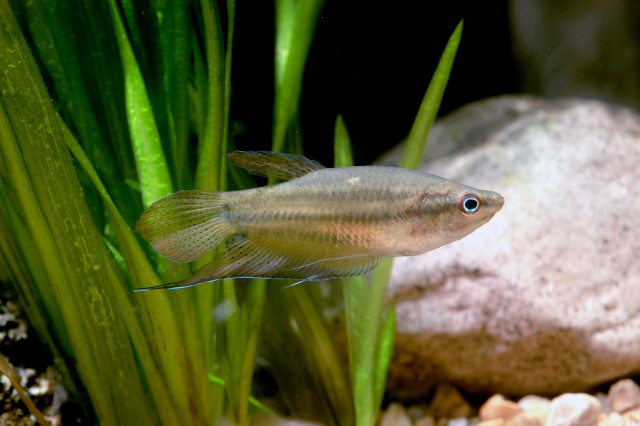Are you looking for a unique fish to add to your aquarium? Look no further than the croaking gourami! These fish are hardy, easy to care for, and have attractive coloration.
In this guide, you’ll learn everything you need to know about their appearance, behavior, care requirements, tank mates, diet, and breeding.
Read on to see if this fish is the perfect fit for your tank!
Here are some quick facts about the Croaking Gourami:
- Species: The Croaking Gourami (Trichopsis vittata) is a small freshwater labyrinth fish belonging to the gourami family1.
- Croaking Noise: As their name suggests, Croaking Gouramis are capable of producing an audible grunting or chirping noise, accomplished through the use of specialized adaptations of their pectoral fins. These noises are produced by both sexes during breeding displays and the establishment of dominance hierarchies among males1.
- Breathing: Like all members of the suborder Anabantoidei, the Croaking Gourami can breathe atmospheric oxygen from above the water surface using a specialized labyrinth organ if necessary. It is important to keep the surface of the water exposed to fresh air, usually accomplished by keeping them in an open-top tank or using a hood that allows air ventilation. If the tank has good air pumps, this may not be necessary, as the air pumps will refresh the air above the water1.
- Diet: In the wild, Croaking Gouramis are mostly insectivorous, feeding on insects, insect larvae, zooplankton, crustaceans, shrimp meat, and occasionally plant matter. In aquariums, a varied diet is important for their long-term health. They can be fed standard flake foods along with regular supplements of freeze-dried bloodworms, tubifex worms, brine shrimp, and some algae-based flakes to provide them with proper nutrition1.
- Tank Mates: Croaking Gouramis are generally peaceful, except during breeding. They can be maintained in a pair or group, and will display some interesting behavioral interactions under the latter condition3.
- Breeding: Breeding Croaking Gouramis is relatively easy. However, to successfully breed them, you may need to provide additional information and specific care4.
- Sex Determination: Sex can be most reliably determined by candling1.
Overview and Quick facts
You’ll find all you need to know about croaking gourami care in this guide.
The croaking gourami (Trichopsis vittata) is a freshwater species of gourami that’s native to Southeast Asia. It’s an omnivore and grows to about 3 inches in length.
The croaking gourami is an attractive fish, with a colorful body and fins. It also has a unique croaking sound that it makes when it’s disturbed.
When it comes to tank setup, the croaking gourami prefers a well-planted aquarium with plenty of places to hide, as it’s a timid fish. The water temperature should be kept between 75 and 79 degrees Fahrenheit, and the pH should be between 6 and 8.
To keep the fish healthy, regular water changes and a protein-rich diet are recommended.
Breeding signs include the male croaking gourami becoming more aggressive and chasing the female around the tank. He’ll also build a bubble nest at the surface of the water.

Appearance & Behavior
You’ll find that the croaking gourami has a unique appearance and behavior. This fish has a long body and a wide head, which is characterized by a curved forehead. It comes in a variety of colors including yellow, orange, blue, and green. The croaking gourami grows to around 8 inches and has a lifespan of up to 5 years.
When it comes to behavior, the croaking gourami is a peaceful fish. It is usually found in shallow, heavily planted areas of the tank and is comfortable in small groups. They are also very social, preferring to swim in pairs or small groups. However, they can be shy around other tankmates and may hide if startled.
| Socializing Habits | Breeding Behavior |
|---|---|
| Spends time in pairs or small groups | Will lay eggs on plants or substrate |
| Can be shy around other tankmates | Males will care for the eggs |
| Prefers shallow, heavily planted areas | Eggs will hatch in about 24 hours |
Understanding the croaking gourami’s socializing habits and breeding behavior is key to providing the best care for it. Be sure to provide plenty of hiding places and monitor its behavior to ensure it is healthy and happy.

Care and tank requirements
You’ll need to provide the right tank setup and care for your croaking gourami in order to keep it healthy and happy. Here are the basics you should know:
Tank Size:
- 20 gallons of water should be the minimum size for one croaking gourami.
- If you plan to keep more than one, the tank should be increased by 10 gallons for each additional fish.
- A larger tank is always better, as it allows more swimming space and encourages natural behavior.
Water Parameters:
- The ideal temperature range should be between 72-77°F (22-25°C).
- pH should stay between 5.0-7.0 depending on the variety of croaking gourami you have.
- The water should be hard to moderately hard.
Other Care Tips:
- Clean the tank regularly and provide plenty of hiding spots and plants.
- Feed them a variety of food, including frozen and live options.
- Be sure to research and be aware of any potential diseases your croaking gourami may be prone to.
Providing the right tank setup and care is key to keeping your croaking gourami healthy and happy. Now that you have the basics, let’s look at what tank mates you can choose for your gourami.

Tank Mates
You can choose tank mates for your croaking gourami, but you’ll need to be careful when selecting them. Healthy tankmates are essential for a safe and peaceful environment for your gourami. Try to select tankmates that are similar in size and temperament, and compatible with the gourami’s water parameters. Compatible fish include other gouramis, dwarf cichlids, and peaceful tetras. Avoid aggressive fish, such as cichlids, which could harass or even attack your gourami.
Research the behavior of any potential tankmate to make sure they’re a good fit for your tank. When introducing a new fish, do so gradually to avoid stressing your gourami or other tankmates. If you notice any signs of aggression or distress in any of the fish, separate them immediately.
Croaking Gouramis can be kept with a variety of tank mates that are peaceful and compatible with their needs. Some suitable tank mates for Croaking Gourami include:
- Guppies: Both Croaking Gouramis and guppies are peaceful fish that prefer similar water conditions.
- Neon Tetras: These small, active tetras make great companions for the Croaking Gouramis and add color to the tank.
- Ember Tetras: Similar to neon tetras, these colorful tetras make great companions in a community tank.
- Dwarf Corydoras Catfish: These bottom-dwelling catfish will not bother the Croaking Gouramis and help keep the substrate clean.
- Mystery Snails: Peaceful snails like Mystery Snails can coexist peacefully alongside Croaking Gouramis while also helping control algae growth.
It is important to note that any potential tank mate should be non-aggressive, have similar water requirements (pH level, temperature), and be appropriate in size compared to the Croacking Goruami as they may target smaller species as prey if there is a significant size difference between them.
Tank compatibility is important for the overall health of your gourami and other tankmates. A healthy tank environment is essential for the long-term health and well-being of your fish. With the right tankmates, your croaking gourami should thrive in its home.
Now that you know about tankmates for your gourami, let’s move on to discuss the diet and feeding.
Diet and Feeding
Your croaking gourami’s diet and feeding habits are important for its overall health and wellbeing.
When it comes to food types, they’re omnivores, meaning they’ll eat both meaty and plant-based foods. A balanced diet should include a combination of flakes, pellets, freeze-dried bloodworms, brine shrimp, and vegetable matter like blanched spinach.
In terms of feeding frequency, a croaking gourami should be fed 2-3 times a day, but only the amount of food that can be eaten within a few minutes. Overfeeding can cause water quality issues, which is why it’s important to keep the tank clean and maintain proper water chemistry.
Here are a few tips to keep in mind when feeding your croaking gourami:
- Food types: Offering a variety of food types ensures the fish gets a balanced diet.
- Feeding frequency: Feeding 2-3 times daily is recommended, but not more than what can be eaten in a few minutes.
- Tank cleanliness and water chemistry: Maintaining a clean tank and proper water chemistry is essential to prevent health issues caused by poor diet and overfeeding.
Breeding
When it comes to breeding, you’ll need to take certain steps to ensure the success of your croaking gourami.
Creating a breeding environment is essential, so you’ll need to make sure the tank is spacious and has plenty of vegetation. Additionally, the water should be slightly acidic with a pH of 6.0-7.0, and the temperature should be between 74-80 degrees Fahrenheit.
You’ll also need to select a mate for your croaking gourami. Look for signs of good health in the fish, such as a plump body and clear eyes. When it’s time to pair them, add both to the tank and observe their behavior. If they appear to be compatible, then they should be a good match. If there’s any aggression, it’s best to choose a different mate.
After the successful pairing, the female should lay her eggs in clumps on leaves or rocks. The male will then fertilize them, and within three days, the eggs will hatch.
The fry will be ready to be fed after a few days. Be sure to provide them with plenty of live food such as brine shrimp or microworms.
With the right environment and careful monitoring, you should have success when breeding your croaking gourami.
Conclusion
You now know everything you need to know about croaking gouramis, from their appearance and behavior, to their care and tank requirements, to their diet and feeding, and even their breeding.
With patience and attention to detail, you can provide your croaking gourami with the proper environment and care it needs to thrive.
With the right tank and tank mates, you and your gourami can enjoy a long, happy relationship together.

